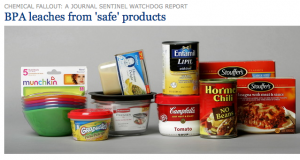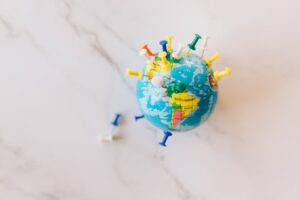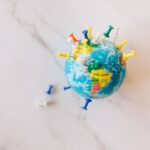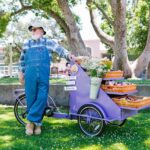Susanne Rust and her colleagues exposed the presence of chemicals, including bisphenol A, in a wide range of everyday household products for the Milwaukee Journal Sentinel in the series “Chemical Fallout.”
It was a piece of journalism that stunned consumers, prompted regulatory change and earned the team a slew of honors.
The series garnered a finalist spot for a 2009 investigative reporting Pulitzer Prize and a George Polk award. Then there was the John B. Oakes award for distinguished environmental reporting, a Scripps Howard National Journalism award, a Grantham award of special merit, a Sigma Delta Chi, a Society of American Business Editors and Writers award, and many more.
We talked with Rust about her experience working with a team to report the groundbreaking series, which was co-authored with Meg Kissinger and Cary Spivak. Here she shares an inside look at collaboratively reporting a document-heavy series, her investigative reporting tips and what she believes are the next big stories in the chemical industry.
How did you collaborate with other reporters and divide the work for this series?
“I pitched about 16 stories I was going to do over three or four months and I realized I couldn’t do it all by myself. Part of the reason I couldn’t do it is I’m not a business reporter and at the time didn’t know anything about industry or business or how to look at tax forms, so I asked if Cary Spivak, who’s a business investigative reporter, could join the team so he could help in that area and really speed that up.
“I had never worked on a really long project like this, and Meg Kissinger had been at the paper for 20 years and she’s one of the most gifted reporters I’ve ever come across, so I just knew if she was on the team we’d be able to get this stuff on paper looking great.
“The way we split it up, well, we barely split it up. In the end, and we probably wasted a lot of time, but the three of us would do almost every single phone interview together. Basically, if it was somebody who was antagonistic, we’d clobber them right back because I could come at them from knowing about science and knowing when they were giving the bullshit factor, Meg could sweet talk anybody into giving us information and Cary could call them out if they were being fuzzy about business stuff, so we hit them from all three sides.
“The three of us wrote it together. We sat down at a computer and switched places and the other two would stand behind and we went sentence by sentence. I did more of the paperwork sort of stuff, I did most of the looking at the scientific stuff, reading government and scientific reports, summaries etcetera. Cary did the business side of it, looking at tax forms. Meg sort of filled everything in between.
You went through a lot of studies, documents and legislation. How did you stay organized and make sure you didn’t leave out anything important?
“We probably still did leave out important stuff. I put everything into three ring binders. I started making a list to myself. Every day, I would write down what I had done and who I had spoken to. I could go back and check and remember who I spoke to and then make a mental memory of where I had put those notes.
“I used several notebooks for this but kept them all together. On the front cover of every notebook, I would write down the name of somebody I’d spoken to and the date. I’m not super, super organized, in fact I’m completely unorganized, but I found with these stories I had to create a system because it was so easy just to lose a notebook or forget where you had put those phone interview notes. So I just started labeling everything in a really macro sense like notebook, binders, folders and then would find things within.”
In your stories, you mention using PubMed and the UW Madison Library. Can you talk about them? What were some of the other resources, programs or tools you used the most during your investigation?
“In the early days we went straight to government agency pages and got a ton of information off of those pages. They have lots of documents online that are freely available, publicly available. Later on, we started doing FOIAs for stuff that wasn’t out there. I put this all into Excel spread sheets.
“PubMed is sort of like a warehouse of all scientific papers. Anything on science or health, mostly health, related issues, you can find there. Any peer-reviewed paper that comes out on those topics, PubMed keeps. So you can go to PubMed and you can put in a search term, you can put in an author’s name, and it will pull up all the relevant papers.
“The thing about PubMed is that it only gives you the abstract, it doesn’t give you the full paper, but it will list out papers for you. For example, I put in Bisphenol A, and it listed out something like 1,700 papers that had either the subject Bisphenol A or Bisphenol A was used as a word in the copy of the study or referred to. Then I had a list I could go to and I could go through every single paper on that list through the UW Library system.”
What are your tips on creating and organizing reporting databases through programs like Excel?
“The trick is really again a matter of organization. It’s making sure you’ve organized your entries correctly or in a way that can be useable. That’s sort of the hardest part; when you’re first sitting down to an investigation, figuring out what should be in the columns and what should be in the rows and setting that matrix up, because if you do it wrong it can become more burdensome and confusing than it should be…it’s sort of a thing that you figure out over time after you’ve failed so many times doing it and making it more difficult on yourself.”
What was the most difficult aspect of your investigation and how did you deal with it?
“I think initially the most difficult part was getting anybody to talk to us. Nobody took us seriously initially because we were from the Milwaukee Journal Sentinel. It wasn’t like we were The New York Times or The Wall Street Journal calling, so initially it would take weeks to get anybody to speak to us. It took constant nagging.
“I think we really overcame that after we published our first story and people realized that we were serious and that we weren’t just a bunch of hay seeds from Wisconsin. I think most people in D.C. and the coasts have absolutely no respect for anybody who lives outside of those areas. I think it was when we published our first story that they realized we really knew what we were talking about and that we were very serious about this reporting, and that it wasn’t just a fluff piece or an activist piece. It was really well-researched and we had in a sense become authorities on the subject by the end of our research on it and I think that was apparent.
“But I think even before that, we would have to do several call backs with some of these sources and they’d blow us off for weeks, but they soon realized that by the questions we were asking and through us talking about the subject that we knew what we were talking about and were serious. It took a long time.”
Do you think more reporters need to look at the methods section of scientific studies and be more critical of who they’re funded by?
“I definitely think if you’re doing medical reporting, if you’re doing scientific reporting or you’re doing environmental reporting, you need to know who funded the study, where the money came from.Once you’ve established that, you definitely should look at the methods.
“It’s hard to do, so I would recommend anyone doing that kind of reporting to find a few good sources who can help them go through a methods section and talk about what methods were used and whether they were appropriate or not. Often the story is in the methods section. As reporters, I think we’re really averse to looking at a methods section because it’s so dry and technical, but again, I think that’s where the story is.”
Is there anything you’d wished you’d known at the start of your work?
“I wish I’d had more confidence in myself early on. Part of the reason the first set of stories took so long was because initially I wasn’t going to sit down and read all these scientific studies and then show what I’d learned from them. I got other scientists to tell me what the research showed. Finally, my editor said ‘Susanne, you’ve been reading this for months now. You know what’s going on. Tell everybody what you’ve seen.’
“I wish I’d had more confidence in myself initially because it could have gone way faster. It wasn’t until the third month into it that I started to be very deliberate about examining every single study and showing what I had seen as a reporter looking at these things.”
In your reporting process what were some of the things you were glad you did?
“I worked with a really experienced editor on this and he really helped us bring it together. He did things that I wouldn’t have done had he not been there, like when we showed our results to the chemical industry before we published, and I was really glad we did because we could get their reaction before it was published and had we had anything glaringly wrong they would have seen it.”
If a business reporter wanted to report on the chemical industry, what are some new angles you’d suggest they look into?
“I think there are a lot of policy issues I think are really going to affect the chemical industry. There’s a law called the Toxic Substance Control Act and it’s been on the books since the 1970s and what it does is puts a very high burden of proof on the government to show that a chemical is dangerous. Legislators are looking to rewrite that law right now, and if that goes through, I think it’s really going to affect how chemical companies market and manufacture their chemicals because they’re going to have to show they’re safe before they put it on the market, which is the direction I think it’s going to go and it’s going to have an effect on their business. Right now, they don’t have to do anything and the government has almost no power to say a chemical is dangerous or to ban it.”
What are your top five tips for investigative reporters?
1. Have patience.
2. Everything you hear is important. Things that are seemingly unimportant may rear up to become very important later on, so don’t dismiss anything offhand.
3. Know your sources inside and out.
4. Be organized.
5. Don’t throw anything away.











